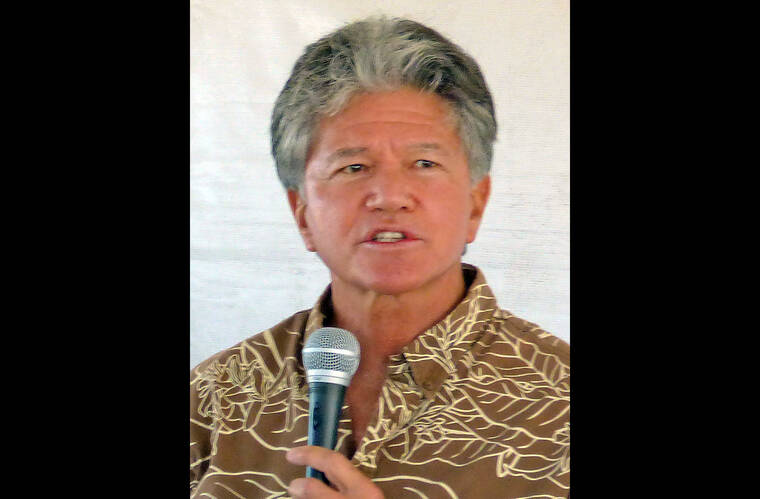The University of Hawaii is hosting what it calls a “virtual public forum” in which the public can ask questions via email about UH’s draft Maunakea Master Plan.
The event will be livestreamed between 5-7 p.m. Wednesday on UH’s YouTube channel at www.youtube.com/user/uhmagazine. The public is asked to email their questions to eforum@hawaii.edu prior to the forum. Questions will be answered during the forum, with those questions submitted earliest being the most likely to be addressed.
The 122-page draft master plan — which is open for public comment until Oct. 26 — can be viewed at https://bit.ly/3l7Nkrx.
“This plan is trying to be responsive to the many values and obligations that we, as an institution have for managing public plans. And so, everyone in the public has an interest, has a legitimate interest in what happens to these lands and how these lands are utilized,” said Greg Chun, UH-Hilo Center for Maunakea Stewardship executive director. “We invite, we encourage, we really want people to come and tell us what they think about the plan.”
Chun said the master plan “needs to be updated because the existing master plan, which was developed in 2000, had a 20-year life, and so it’s time for us to update it.”
“We also need to update it because this is a crucial step in securing a new master lease,” he said.
The 65-year lease for the 11,288-acre Maunakea Science Reserve — which hosts 13 astronomical observatories — expires in 2033. A nonexclusive easement for the Maunakea Access Road, about 71 acres, also expires in 2033. The lease for the 19-acre Halepohaku midlevel facility expires in 2041.
UH has been under fire over what critics call mismanagement of the portion of the mountain it controls, and in February, state House Speaker Scott Saiki said it’s time to replace UH as the management entity of Maunakea.
Speaking on the floor of the House, Saiki said the university should stop its pursuit of renewal of its master lease for the mountain. He introduced a pair of resolutions, and a Maunakea Working Group was formed, with diverse stakeholders meeting to develop recommendations for a new management structure for the mountain.
The mountain was the site of protests and arrests in 2019, as opponents of the proposed $2.4 billion Thirty Meter Telescope project staged a massive blockade on Maunakea Access Road, stalling construction activities for months before winter. And then the coronavirus pandemic set in, essentially shutting down any construction activities on site.
Thousands of the protesters — who refer to themselves as kia‘i, or protectors of the mauna — also blockaded the road in 2015. Many of the demonstrators consider the mountain sacred ground and believe that building the next-generation observatory amounts to desecration.
A 1998 state audit was critical of the university’s management of the mountain, although there have been official sources citing improvement since then, including a 2000 report by the Department of Land and Natural Resources and a 2017 Preservation Commendation Award by the Hawaii Historic Foundation to the UH Office of Maunakea Management, the UH-Hilo Center for Maunakea Stewardship’s predecessor.
There remains, however, vocal critics of UH’s management of the mountain, including Saiki, who said in his February floor speech, “The university has tried its best to manage Maunakea, but for too long, the university’s work has been shrouded by its inability to appropriately manage cultural practices, resources and education.”
UH’s draft document reaffirms its support of astronomy at Maunakea’s summit. Calling astronomy “the single most important reason for its position on the mountain,” the plan said the university “recognizes that Maunakea is a distinctive and revered mountain and acknowledges Native Hawaiians’ unique responsibilities to the care of the mountain through their religious and cultural practices.”
“While UH will continue its strong support for and involvement in astronomy on Maunakea, it will simultaneously strengthen its support of research and educational programs in indigenous, natural, and social sciences,” the plan states. “UH also recognizes that kanaka maoli’s (Native Hawaiians’) timeless knowledge regarding Maunakea, reflected in their observations shared in mo‘olelo (narrative story) and mele (song or chant), are no less significant than other knowledge and these will be acknowledged, protected, and expanded within UH’s management and curriculum. UH will incorporate Maunakea into its programming across departments within UH-Hilo and across schools in the UH system.”
The draft master plan calls for no more than nine working observatories in the Maunakea Science Reserve by the end of 2033.
The Caltech Submillimeter Observatory closed in 2015, although it has yet to be removed from the mountain. And UH’s Hoku Ke‘a teaching telescope is slated for removal from the summit.
Current plans, outlined in the draft master plan, call for a new teaching telescope to be reinstalled at Halepohaku — a plan that drew the disapproval of some attending an online public meeting last month.
Also in the plan is the establishment of a UH-Hilo-led multidisciplinary field station at Halepohaku to support field studies and learning experiences across disciplines.
Email John Burnett at jburnett@hawaiitribune-herald.com.






